Tuesday, December 23, 2008
An Update
Thursday, November 6, 2008
Help!
Monday, November 3, 2008
Rethinking
Friday, September 5, 2008
Slow Progress
Anyway, I've picked the toolset back up in the meantime and am trying to flesh out my city a bit more with some new areas. I've built a few areas and put few or no placeables in the, just so I can get an idea of how the city layout will look. I've also started making some interior areas. I'm mostly just adding the shops that have signs out front, but I'm also making sure I have at least one quest in each one as I firmly believe every place should have something to do. Some of the quests are not availabe right away. You'll have to chat people up and get them to like you before they trust you enough to let you help them. How you do this depends on the person. Merchants like folks that make big purchases, and you can chat with most people to increase their reaction to you. I'm also letting people use the social skills NWN provides to influence each NPC.
Here's a couple of screenshots of some of the new areas I've created. First, Hollander & Sons. I'll let you guess what they do for a living.
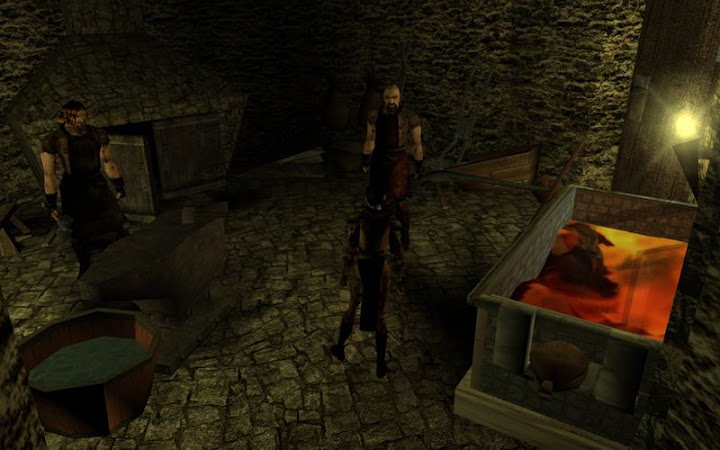
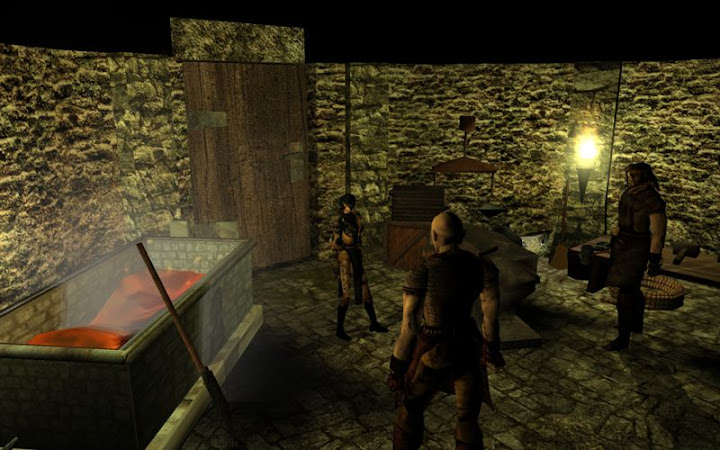
Grisham's Textiles is next. This is where PCs can buy and sell clothes and cloth, as well as a selection of dyes. He doesn't fit in well with the rest of Manheim Court. Perhaps talking to him will dig up some information on why his shop is in such a poor location for one with such fine goods.
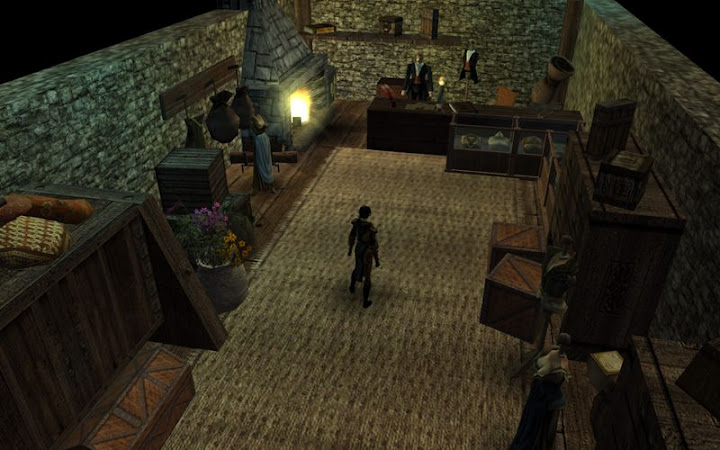
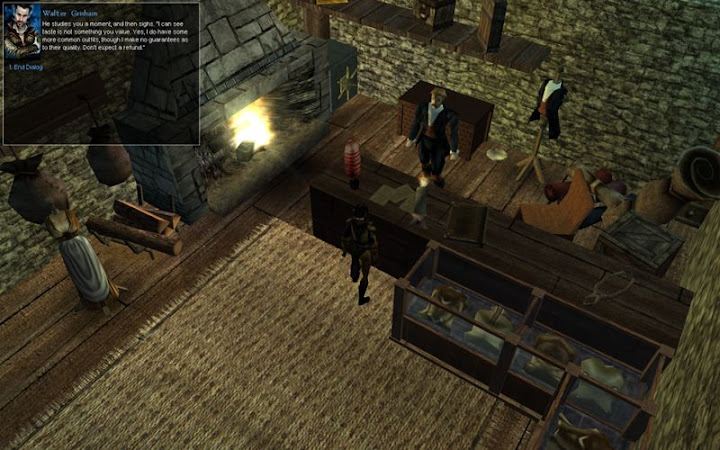
Finally, here's Aether Armors, formerly Sundry Armors. When AetherTech Industries bought this shopkeeper out, he got the short end of the stick. He's anxious to get back at them, and patrons that help him could profit... if they don't get caught.

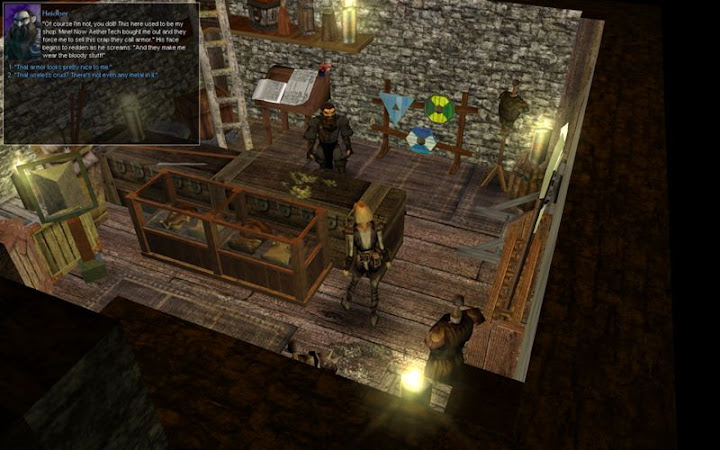
I'm finding interiors easier to design as I go along. They tend not to be as cluttered as the outdoor areas. My thought is that people who own shops tend to keep things more organized than those who cry their wares on the streets. It's also a bit easier to work with sounds, too, since you have less going on indoors than outdoors.
It's coming slowly, but hopefully it'll keep flowing. Enjoy the screenshots!
Wednesday, July 23, 2008
Getting there...
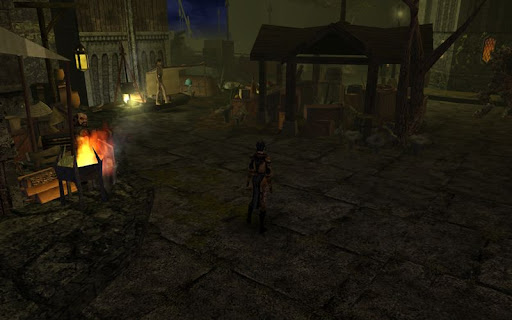
I've also added some story elements into the NPC conversations. I want the world to be immersive, and that means each person should have as much depth to them as possible. Dialog writing takes time, but it's one of the more rewarding parts of building for me.
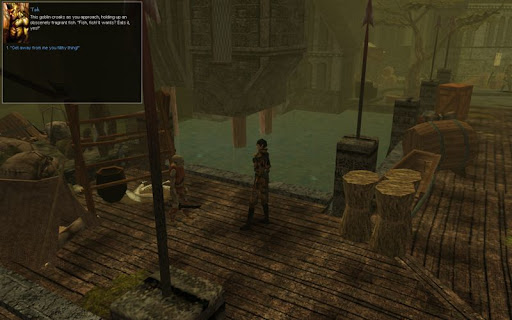
Seeing dialogs pull the player into the environment helps me see where I'm going with this whole thing. For instance, Errol's complaint of having to look at Gretchen's food store all day without being able to afford to buy anything. That's pulling the player into the game right there. FP suggested I add some more elements to that, though. As you can see here, I added a little growing something into the pot by his bed (FP's suggestion). Maybe he'll eat it when he's hungry and foolish enough.
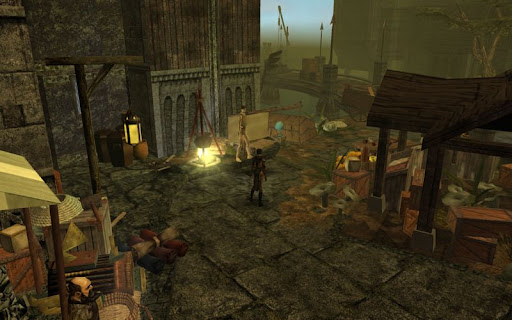
I've also begun adding more NPCs. Some of these fellows will be sitting down or walking around once my ambient system is working (yep, yet another system I'm doing from scratch; *sigh*). In this shot, there's a Federal agent wielding a government issue sidearm, a typical Midport guard, and an Automat. Automats are a recent invention in the world of Shadows & Silver; they're similar to golems, but based on science rather than magic. You'll see lots of them around the world and (if I get time to write the scripts) even be able to make or purchase one of your own.
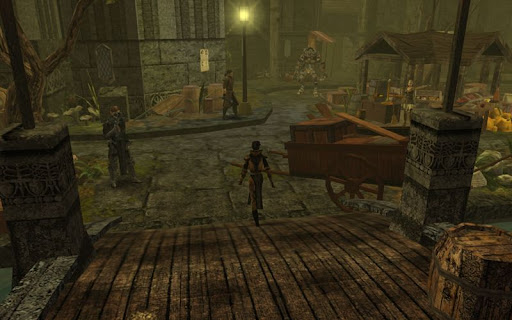
You can see I'm adding plenty of placeables, but not every shop needs tons of wares around it. Here's a simple one that was quite fun to make.
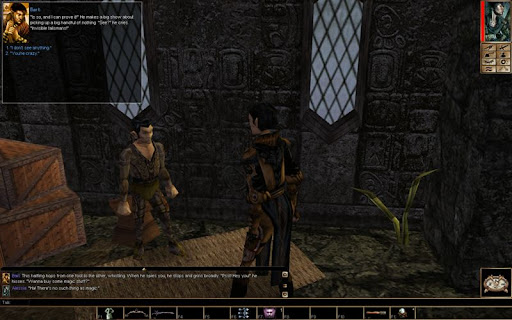
Hope you enjoyed the shots. Here's a few more just for kicks.

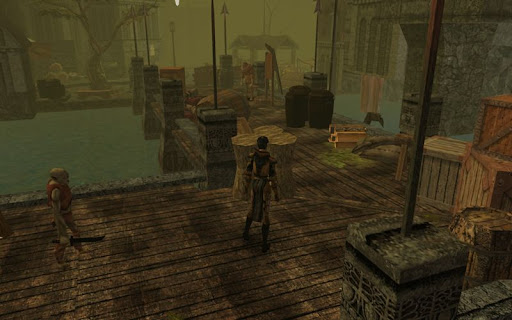
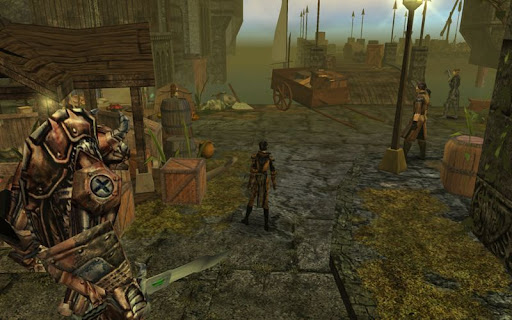
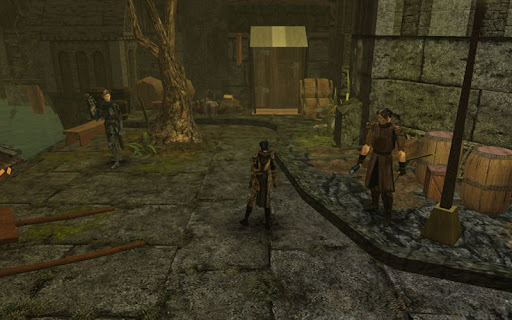
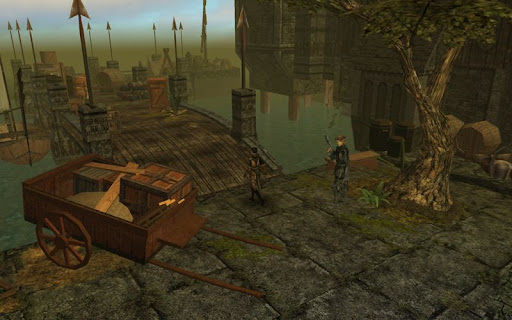
Friday, July 11, 2008
Some progress
In other news, I've picked my building back up. I've connected two area to Manheim Court, but they don't have anything in them worth showing yet. Here's some screenshots, though, that show how my first area is beginning to fill out:
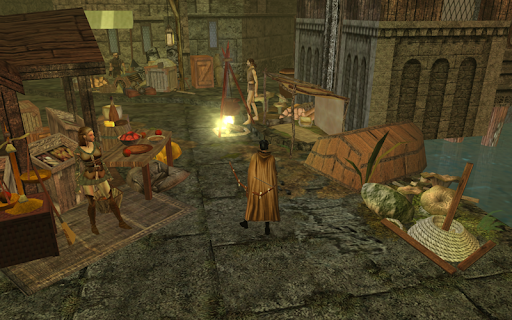
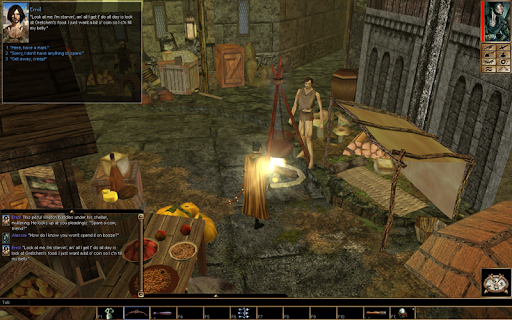
Saturday, July 5, 2008
The Scripting Continues
Building a PW is a lot of work, I'm finding. I've spent hundreds of hours scripting the systems for Shadows & Silver, and I'm beginning to feel rather worn out. The XP system and reputation system Casa and I are sharing are still in beta. I keep running into brick walls with them, and the frustration has been mounting for quite a while. One of my problems, I think, is that I refuse to incorporate anything into my world unless I know exactly what it does, how it does it, and why. This means breaking open every script and reading through it line by line. What's more, I'm making everything conform to my own scripting standards and making it easily customizable, which means rewriting pretty much every script from the ground up. This is what I did with Knat's XP system and with Vendalus's PRR. They're totally redesigned, rewritten, and expanded. That's a lot of work, but I hope the gain of being able to customize the settings and understand things enough to change them at will makes it worth it.
I while back I published the list of things I was wanting to script. Here they are again plus a bit more, reorganized by priority:
- A custom XP system with class-based rewards
- Persistent reputations with NPCs and factions
- Persistent quests and journal entries
- A custom spawn system
- A crafting system
- A whole new magic system (yes, you heard that right)
- A D&D 4th Edition-style resting system
- A D&D 4th Edition-style bleeding and death system
- An inn room rental system
- Persistent chests and banking
- A cut scene system
- And a whole lot more
The first three are in beta (though I'm about certain the quest and journal system works flawlessly, I'd like to add a feature or two before I call it final). I had an old working version of persistent chests before I lost the mod in a hard drive crash, and I've got a tweaked version of Gestalt's Cut Scene System in alpha. Both of these are rather low on my to-do list, though, since there's few places I intend to use them. I've not even begun my crafting, death, magic, resting, or inn systems yet, and I want to have all these in place before I open the server up for beta testing.
*sighs*
Well, let's at least start getting a working prototype of these systems in place. Getting things started is half the battle with me (the other half is getting them finished).
As I've said previously, the difficulty with scripting is that you've got to know what you're trying to accomplish before you ever open the script editor. If you sit down and just start scripting with no predefined direction, you're going to be lost in a sea of tangled code. So I'm going to begin with the spawn system, listing the requirements of the script:
- It must conform to HCR2 coding standards. This means the code should be broken up into short, manageable functions, and it should be self-documenting, requiring few, if any, comments to explain how things work. There should be no inline strings used in the code (e.g., int nNum = GetLocalInt (oPC, “somevariable”);); strings should be defined as constants elsewhere to cut down on errors. Lastly, anything the user may need to change should be placed in a separate configuration file so the user need not wade through large amounts of code.
- It must be able to spawn NPCs, monsters, items, and placeables. Preferably, the same code would be used to handle all of these spawns.
- It must be able to spawn on a timer or when a PC enters a trigger.
- It must be able to spawn multiple creatures or items of the same or varying types at one waypoint.
- It should be able to vary spawns based on time of day, the level of the character triggering the spawn, etc.
- It should allow a DM to quickly place spawns for on-the-fly encounter design.
- I should be simple for non-scripters to use. The easiest way I see to accomplish this is by making the system be based on waypoints and triggers, which can easily be added to the palette.
- It must require a minimum number of scripts to operate. I would find 10 or less scripts acceptable.
This is a good list, and it gives me a bit to start with. But one thing that is lacking is user configuration. One of the things that made my XP system so flexible was its massive list of customizable variables. What sorts of things would a user want to be able to modify that would need to be set in a customization script as opposed to on individual waypoints? The first thing that jumps out to me is default settings, which was what the bulk of my XP customization was. As for what things in a spawn system to have defaults set for, though, I have no idea. Anyone?
Tuesday, July 1, 2008
Again?
On the other hand, I got to talk with Fester Pot, creator of the Almraiven module. If you haven't played this module, I highly recommend it. It's a city adventure that's heavy on the role-play. The most amazing thing about it is the incredibly believeable city. FP makes Almraiven come alive with excellent use of sound, placeables, and tight streets. This module has become my favorite and a great inspiration. Of course, you have to make some changes to form it into a PW, and building something this intricate is much more time consuming than designing a bunch of sparsely populated areas, which is what I've seen on many PWs. The payoff, I think, will be worth it.
There's three key components FP mentioned that I'm trying to keep in mind: small areas with lots of alleys and tight construction, liberal use of placeables to give that lived-in feel, and heavy use of placed sound. Here's a couple of screenshots of the first area I've designed using FP's advice. As you can see, I'm only just starting, and there's lots of odd, empty spaces, even in this 5x5 area. Getting a variety of placeables that still seem to flow together is difficult, and I've never been much good with building anyway. Still, it's a start.
Morgan, one of the first NPCs players will meet.
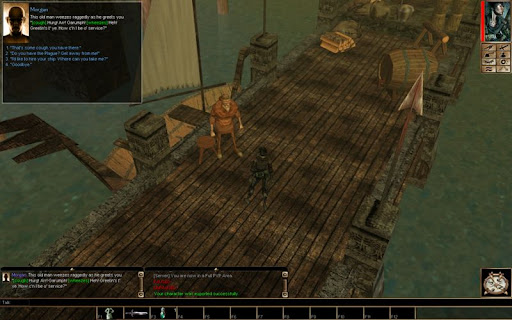
Manheim Court, with two shops so far...
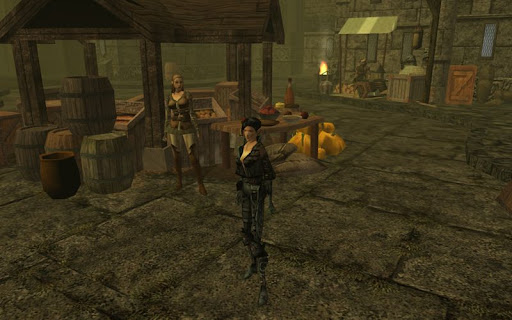
My favorite screenshot. Heiden, inventor-turned-junk-seller.
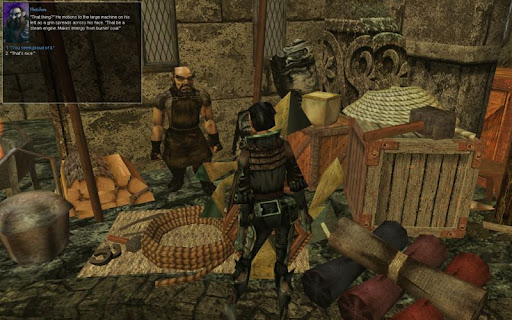
Cheers!
Saturday, June 14, 2008
Assumptions
In 4E...
- the world is more fantastic. This is a huge step forward. Previous editions of D&D felt the need to have every one of their lands and cultures be an analogue of some real-life culture. This was especially prevalent in the Forgotten Realms, where Oriental Adventures (Asia) and Matzica (Yucatan) were straight out of real life, and as such did not fit with the rest of the setting. Some of the cultures, such as the Ffolk of the Moonshae Isles, fit with the setting but were still so close to real life that it often broke the fantastical portion. Go with what makes sense in your setting, not what happened in reality. Shadows & Silver, like 4E will often be inspired by real life, but it will also have things for which there is no historical analog.
- the world is ancient. In Shadows & Silver, countless empires have risen and fallen, and many of them have been lost to history. Not even the immortal fae remember all of history. Those whose mythology tells them how the world or even their race was created may be correct, or the tale may have been so twisted in the countless of thousands of years of retelling that it is completely false. Because the world is so ancient, there is no end to the mysteries to be uncovered.
- the world is mysterious. Even in the scientific awakening of modernity, man knows only so much about his world. True, his empires have been vast and his explorers have gone far and wide. But danger and disaster keep most folks at home, leaving what is beyond the border to the adventurous. Most folks know some about what lies beyond their home, but only those who have been there know anything beyond myth.
- monsters exist all over. In this, Shadows & Silver differs from D&D. Monsters are thick in my world, though they have been driven from the lands and thoughts of men. They lurk in the mysterious reaches of the world, and in those old, haunted ruins everyone's always afraid to go into. In civilized lands, though, monsters are rare, and people who believe in them are rarer.
- creatures need a place in the world. Everything that exists has an origin, and fantastical races and creatures are no exception. Many creatures have their origins in the original creation, or evolution, or even magical experiments. None exist without a reason.
- adventurers are exceptional. While not everyone needs to play a great adventurer, those who do will find they stand high above the common folk. Sure, the world has its heroes, but killing an orc in battle is extraordinary. Killing a dragon is enough to make a man a legend for decades.
- magic is not everyday, but it is natural. This I disagree with most of all. In Shadows & Silver, magic is nearly a thing of the past. Those few who do believe in it are judged to be either crazy or uneducated. Wizards do exist, but they carefully hide their activities for their own safety. In less civilized areas, mages can display their power much more openly.
- "good" and "evil" mean more. 4E makes alignment actually mean something. People don't fight against evil because they're good, they are good because they fight against evil. Evil is more than just bad thoughts. Because of this, very few people are aligned to good or evil. Judging someone's alignment is no longer possible with spells; you've got to judge based on that person's actions. This flows excellently with Shadows & Silver. The shades of grey concept is easier if good and evil are not so cut and dried. Being good is not about being nice, and being evil is not about being mean.
- the gods are remote. In Shadows & Silver, the Archons still grant power to clerics, but their direct involvement is a thing of ancient times. Some suspect that the Archons are dead and that the clerics are actually tapping into forbidden arcane sources. Whatever the case, man must rely on his own deeds rather than divine intervention.
- there is one sun and one moon. Shadows & Silver does not need some fantastic astronomy or absurd setting to make it interesting. The interest comes from the stories told within it.
- there are no forced race relations. I disagree with this somewhat. Sure, just because you're playing an orc doesn't mean you have to be enemies with elves and men. But racism runs high throughout much of Shadows & Silver, especially with those races perceived to be monsters.
- death matters differently. This is something I've hated in all previous versions of D&D. Coming back from the dead was simply a spell and a bunch of diamonds. In Shadows & Silver, returning from the dead comes at an enormous cost (but I won't reveal what it is yet ;) ).
- there are fantastic locations. Too often have I seen PCs adventure in places that are just not that interesting. The places you go should be as exciting as the fights. They should have effects on the battles and on the adventure in general. Shadows & Silver will have a lot of this.
- there's less evil fighting evil. This I'm mostly indifferent about. Since the world is not good versus evil, it doesn't really matter if evil fights evil. The world isn't cut and dried. What is important, though, is that the antagonists present a suitable challenge to the protagonists.
Well, that's a fair overview of some of the assumptions of the world. We'll do a little more scripting and building before the next post. See you then!
Wednesday, June 11, 2008
Frustrations... Again
Further frustrations are in my scripting work for Casa. The XP system has some bugs that need to be worked out, but the biggest problem is a design flaw: it requires creatures to have a particular death script set on them. Now, that's fine for any custom creatures. But CEP creatures and those from the standard palette can't have their scripts changed, and that means creating a custom copy of those creatures. While I plan to pretty much use all custom creatures myself, thus negating this issue, Casa doesn't, which means he needs me to rewrite the default death script to use my scripts instead. Simple enough. But then it occurs to me that this problem could pop up all over the place. What about when I write a spawn system? The creatures will need custom spawn scripts. And what if I have a standard creature that needs one custom death script and another that needs two? I can't have the same script run two different things. So I'm basically rewriting all the default creature scripts to use my HCR2 1.6 creature events, and putting the original BioWare code into their own scripts, which he can set to be called if he wants. The problem is, it's insanely tedious, especially since I'm having to write documentation on each one (something everyone should do in their scripts but, lamentably, few do). Add to that the difficulty in working on someone else's computer and you see some of my problem. The good news is that I'm almost done. Hopefully this weekend the scripts will be fixed and I can go back to bug testing the XP system.
Speaking of the XP system, if anyone wants to help me test it (not sure how many folks there are who read this), please shoot me an email (squatting_monk at yahoo.com) or comment and I'll send you a sample module. I plan on posting it on the Vault when all the kinks are worked out, both in an HCR2 version and in a stand-alone version.
Friday, May 30, 2008
Frustrations
*sighs*
Monday, May 12, 2008
Scripting the XP System
Well, the problem with scripting is that it's not like building. With building you can open the toolset and fiddle around until you have a nifty idea or a fit of inspiration. With scripting, you need to know what you want and have already figured out how to get there. It's harder, I suppose, though I honestly prefer scripting because constant planning is more reliable for me than fits of inspiration, and I'm more likely to get a bunch of scripting done than a bit of building.
Why the rant, then? Well, I'm getting jittery. I've got so many neat ideas that I want to pull off in this world, but I'm still stuck doing the basic systems. I know that if I jump into scripting the cool ideas I have that I'll just have to come back later and restructure things to work within the confines of my base, which means more work and lots of headaches. Still, it's aggravating to still be working on an XP system, my current project. That said, I've accomplished quite a bit on it, and it's an extremely robust system that Casa and I will both be using in our worlds. The trouble is, I've had to cut some of the features because they were just impractical. That's the problem with designing large systems (and the XP system is well over 1500 lines right now): you're tempted to throw too much in, and if you're not careful, it becomes a veritable maze.
I'm to the point where I can start writing some documentation on it, and documentation helps, not only because it lets others know how to use the scripts, but also because it makes sure you've covered everything you needed to. You'd be surprised how often you can build a large system only to realize later that you've forgotten one or two pieces of the puzzle that are necessary to actually make it work. For now, though, let's look at the features of my XP system (based on Knat's Flexible PW XP System and the Vives class-based rewards). The following is a list of features I told Casa the system should have. What I've finished (for the most part) is crossed out, what I still have to do is in red, and what I've dropped from the system is grey:
- Change the overall XP gain rate in one setting
- Change XP gain for custom subraces
- Overcome multiclassing XP penalties
- Keep players from exploiting the game by not levelling up as soon as they get the chance
- Change XP gain for individual levels to make advancement easier or harder
- Change XP gain for individual classes (useful for putting those HiPS-spamming
- Shadowdancers in their place)
- Modify the XP gain of each class based on whether it's Ability, Combat, Crafting, Discovery, or Magic XP
- Change the overall Ability, Combat, Crafting, Discovery, and Magic XP gain for all classes
- Easily change whether or not XP types base their rewards on DC or flat rates
- Award extra XP for extraordinary success in skill rolls
- Reward partying in combat
- Give a kill bonus to the PC to deliver a killing blow
- Modify the XP gained from monsters too far from the PC's level
- Reduce XP for PCs too far from the average party level
- Persistently reduce XP gains from killing the same monster or casting the same spell over and over
- Give Rangers a bonus for killing their favored enemies
- Keep PCs who are miles away from the party from getting everyone else's combat XP
- Change the XP soaked up by other PCs in the party, henchmen, and summons
- Gain XP for using skills, including perception, diplomacy, and thievery
- Gain XP for using Bard Song, Animal Empathy, and combat-related feats
- Get XP for crafting based on the difficulty of making the item
- Get XP for discovering new areas, tidbits of information, and random things of interest
- And most importantly, every setting can be customized or even turned off
As you can see, things have come a long way. Using the system will be easy, but there's a lot of complicated stuff going on in the background. There's only a few things left in the list, but those things are incredibly tedious. I need to hook into Bard Song, spells, combat-related feats, and plenty of other really boring things. Hopefully I'll force myself to do it in just a couple of days and I'll have something Casa can test.
Until then, folks!
Wednesday, May 7, 2008
The Base, Part 4
A local authority:
Any home base needs to be at least somewhat stable. You don't want it being invaded by monsters or constantly having revolutions or wars. at least, not until your player base is sufficiently entrenched in the world to do something about it. Someone needs to keep control. In the case of our home base, we've already decided that whoever runs the place ultimately bows to the Church, so it could be run by the clergy. However, we also know that the local nobles manage to keep food locked away from the masses. Nobility suggests a monarchy. Now, while there is a historical precedent for clergy and monarchy vying for power, that smacks of the Middle Ages, and I want something more modern. Imperialism is closer to the attitudes I imagine people in this world having, so let's use that.
Our city was once part of a large mannish empire that spanned much of the known land. It had spread by conquering feudal territories, and those rules that surrendered peacefully were promoted to high-ranking government offices. Often, this meant oversight of local industry, which was controlled by the state. After the fall of the empire (due to plague and the recent war), many nobles fragmented their lands with war as they tried to carve their own feudal kingdoms from the carcass of the empire. As one of the core provinces, our city was particularly favored by the imperial Church, which worked hard to maintain order. As a result, most of the original government still stands, though lack of oversight by an emperor has allowed the officials to seek their own interests, rather than the good of the state. The government, then, is a small republic which represents the upper class: former imperial officials, wealthy families, and businessmen. Wealth gets you a place in politics, and the purpose of the political system is to maintain the privilege of the elite. The fact that the city is one of the primary trading ports in the old imperial lands means that they make quite a killing.
Who, though, is in charge? I'll settle on a fellow named Albus Engelhardt. Though he comes from a long line of nobles, he's chosen to ally himself with the imperial remnant, preferring his title of Governor to any conferring royalty. My inspiration for him comes from Havelock Vetinari of the Discworld novels. He's ruthless, but smart enough to realize he can't be brutal. As such, he courts the Church, and their charity work helps to pacify the populace. He also maintains efficient control over the republic, guiding policies so that the only entrench him more into power. Also of note in the city are the Harbormaster (who controls the docks and, thus, trade), the Marshal (who commands the city guard), and the Pontifex (the local head of the imperial Church).
That's a major piece of the puzzle, which means we need a secret about the rulers. I'm settling on the fact that Engelhardt has orcish blood in his veins, a fact he keeps quite hidden.
Townsfolk:
A city isn't just composed of rulers. They have to have someone to rule, and these are the people who the players will encounter most often. Where do they live and what do they do? What lifestyle do they have? How many are there?
I already know that the poor are starving wretches. But my more modern civilization suggests there is a rising middle class. I'm going to divide my townsfolk into three groups, then: the upper class (the aforementioned nobles, but also business owners), the middle class (merchants and shopkeepers), and the lower class (factory workers, farmers, and laborers). I know I want my city straddling a river, and this provides the perfect opportunity to split them up. The southern side of the river will be called the Southside, and is largely slums where the poor live. The Upper Side (side the Northside just doesn't sound as neat as Southside) is where the upper and middle class live, though the upper class citizens live in walled communities. The centers of business are located near the docks, so the wealthy either conduct business there or works from their homes through aides. I think my middle class's shops should be located in high-traffic areas such as the major roads and the docks, though there will be a few mingled with the general housing. The slums have plenty of little gardens and street merchants, but most of their work is done in the large factories the slums are centered around. The desperate and criminals slave away at the water treatment plant upriver. All in all, I'd say there's around 70,000 people in this city. There were far more, but many have fled or died because of famine and plague.
What's a secret for this? Those plant workers? Their bodies and minds are often horribly twisted from constant exposure to the toxins in the water, and there are a few communities of crazies scattered throughout the slums.
Shops:
Players need to buy things, and NPCs need to make money to survive. The lower class is likely to be more self-sufficient than the upper and middle class, since these two groups often specialize in their labor types. This means you'll generally find more shops in the richer quarters, and the shops will be more specialized the more wealthy those living in the location are. what types of things are for sale? What is the place known for? What is rare and in high demand? What is worthless?
Since factories are common in this city, we'll say there's plenty of manufactured goods. Metal implements are likely sold by large businesses, and they'll likely be cheaper than hand-made ones. Still, in a city like ours, crime is probably high, so basic weapons are likely to be easily obtainable. You'll be hard-pressed to find heavy armor or martial weapons here, though; those are banned by the government unless you have a licence. Wooden or cloth items are likely to be made by the general populace, though. I'm going to imagine that fine clothing, food, and books and other intellectual pursuits will be marks of wealth in this city. Local food is probably limited to bread, fish, and bland vegetables, so meat, spices, and fruit are likely to be hot commodities. I'm going to have some fun here and take a page from Firefly: some manufacturing companies have managed to synthesize proteins and combine them with high-density carbohydrates and other nutrients into bland but relatively nutritious food, sort of like protein bars. Everyone hates it, but it's cheap.
As for a secret here, I'm deciding that there's a thriving black market located in the sewers and slums. If you have the money, you can get some exquisite goods; but these are often stolen from nobles or the Church.
Temples:
Religion needs a place in most towns. Especially when people are as bad off as they are in Shadows & Silver, people need an opiate. Here, the Church fills this need. As the only sanctioned religion, it has small chapels and shrines scattered throughout the city. In the poor quarters, the chapels often are centers of charitable work, and soup kitchens are common. In the richer areas, they serve mostly to receive donations and prey on the rich's guilt over their oppression of the poor. The local pontifex makes his abode at a grand cathedral on an island in the middle of the river (which is where I'm also putting the seat of government).
Other religions are not as common as the Church of the Archons, but their cults do exist. Clergy of the Elemental Tides and the Fae Courts find their greatest supporters among the poor, who seek a change in the status quo. While the Church does not actively oppose these religions, their followers are often seen as troublemakers and are rarely trusted. Here's a secret: demon- and devil-worshippers are found most often in the wealthy sectors, where it has become vogue to dabble in black arts forbidden by the Church.
A fantastic element:
This is a fantasy, so we need something fantastic to distinguish the place and make it stand out in the minds of the players. I'm going to make this a secret about the city: some of the populace in the poorer quarters are afflicted with lycanthropy. On nights of the full moon, they roam the shadowy alleys. Their existence has never been proven, since the Church works behind the scenes to exterminate them. Gruesome killings are reported fairly often, though these are usually attributed to local gangs.
Alright, that's a lot of good stuff. But one thing is still bothering me: I don't have a name for my city. I've thought for a long time and think I've finally settled on one: Midport. I'm thinking it'll have been named for the island port in the middle of the river, which is now called Midport Proper. Sounds good!
So now I've got plenty of good solid details about Midport. How about some screenshots? The following pictures are made using the Gothic City and CC City Exterior tilesets, available on the NWVault. I think I like the Gothic City look better, since it's darker. It also feels more modern than the medieval-esque CC City Exterior shots. All of them are devoid of placeables and NPCs, though I went ahead and put some doors in so they didn't look too odd. Look at 'em and tell me what you think. First the Gothic City...




And now the CC City Exterior...




Next time we'll work some on the world at the national level. Until then, enjoy the screenshots!
Friday, May 2, 2008
The Base, Part 3
At minimum, a game world should contain two things: an adventure site and a place where players can rest, sell loot, and buy equipment. Usually, the place where they rest is where they will start in the game. It makes the most sense, really, as it gives the players a chance to stock up on equipment so they don't get slaughtered in their first adventure. The ideal location for a home base like this is a city where all the PCs needs are met... if they have enough money. A home base also needs to have adventure hooks so players have a reason to go out and kill things and take their stuff (something that's all too lacking in many of the modules I've played).
But even going around killing things and taking their stuff gets old after a while. You'll want to keep plenty of things around for the players to do. This means having plenty of quests, new things to discover and, of course, more things to kill. You don't want to design all these new things up front, though. Remember the first rule of Dungeoncraft: never force yourself to design more than you need. What you do design, though, should have lots of hook-ins for you to later expand your world. Mr. Winninger thus states the second rule of Dungeoncraft: Whenever you design a major piece of your world, make some secret to go along with it. That can be just a bit of lore that changes how people would see your world (or, at least, that aspect of it) if they knew it.
You don't want everything to be a big, jumbled mess, though. Everything should flow together logically. Your players may not have all the details as to why things are the way they are, but you should, and everything should make sense from your omniscient viewpoint. I'm going to create a third rule of Dungeoncraft, then: everything you design should make sense in the context of the whole world.
Let's start building my world, then, by thinking up a home base. In accordance with Rule 3, I want a place that embodies many of the themes of the world. This will help the players to understand right away what kind of world Shadows & Silver is. My first inclination, then, is to make it a city, one that reeks of the problems of modernization. I've already talked about wanting to have natural disaster and famine play a part in the daily struggle for survival that so many face, so we'll start by supposing this city was one of many battle grounds for a fairly recent war that destroyed much of the terrain. The ground no longer supports hardy crops, and the water has become poisonous. That's some war! Well, in accordance with Rule 3, we've got to make it make sense. Why do people still live here if it's so bad? The obvious answer would be that the rest of the known world has gotten so bad that this is simply one of the best places to be. But how do they get their sustenance? I've long imagined that the city straddles a river at the mouth of an ocean, and a ways upstream they've built a large facility that purifies the water. It does this, of course, at a cost of high air pollution. But it's more important to have drinkable water than clean air, right? This is a great example of people turning to technology to answer problems technology caused, all the while making things worse. I'll also suppose that the city itself wasn't the site of the battle. No, that was further upriver, and all the fallout washes downstream. It's soured the soil, but the treatment plant is slowly allowing things to return to normal... except its air pollution makes crops suffer, so there's a limit to how well crops grow.
So what I have here is a sort of environmental hook. Our city is a place where people find it very difficult to get anything to eat. Because of where it's situated, it's probably a trading hub, since it can send ships up and down the coast as well as up and down the river. This means it can also likely get food by trade, but that food is bound to be expensive, especially if other lands are having similar troubles. What does that imply about the nature of the city? Well, it gives me an opportunity for a classic rich vs. poor conflict. The rich hoard all the food while the poor starve.
Okay, Rule 2 demands we make some secrets to go with the major pieces we've put together. Now, I don't want to make anything too spoiler-ish here, in case future players of my module are reading this, but I suppose it's necessary if I want to show the build process in action. I expect that no future players will use this information to metagame.
There's three major pieces I've shown so far: a major war that devastated the countryside, a water treatment facility, and rich people hogging all the food. The first one, I think, is that this huge war was instigated by industrial corporations hoping to profit from selling war machines to the government. That may not be much of a secret. I imagine that, while plenty of people have a patriotic streak and think that their country was justified in whatever war it entered, many are cynical and see no gain from the war. Oh, and we'll also say they lost (as may be guessed from the devastation caused to the countryside). The second one is fun, too. The corporation that owns the treatment facility is one of those that instigated the war. All lands watered by this river now have to pay them as much as they want unless they want their people to be horribly poisoned from the fallout. The one about the poor people starving: no matter how little food they receive, they still manage to catch enough fish to survive. How they can catch anything reasonable in the still somewhat poisoned water, though... well, I'll hang onto that one. I've got a wicked idea that will probably become one of my adventures on down the line.
So now I've got a great start for my home city, some neat hooks to tie future plot lines into, and some basic conflicts. We need an adventure hook, though. How's this: the other party in the big war was an alliance of orc tribes, which took up residence in the spoiled parts of the land. They're hardy enough to survive in those places, but they're spreading. The local authority wants them pushed back. This suggest an adventure area where you get to fight orcs. It's not because the orcs are evil that the authority wants them driven out; it's because they have something he wants.
Which leads me to a secret: the spoiled land isn't worth much in its present condition, so the argument that the land only wants its territory back is a weak one. I decide that there's something of incredible value in that territory that civilized leaders want badly enough to risk war to get. I don't know what it is yet, but that's okay. If they told anyone, there would be a risk that the orcs would find out and they'd start looking for it. No, instead, they just pay top dollar for any magic items brought back, regardless of what they are. I'll further suppose that it's not the ruler of this city but the head of the Church that wants them, and he's only told the local nobles that he wants any magic items that are found. Oh, and magic items have been declared contraband by the Church anyway, so anyone caught using them is committing a crime. Turning them over to the Church and getting paid is better than rotting in a jail cell any day.
Great start! Next time we'll tackle some more of the specifics of the world like government. In the meantime, I'll keep working on building so I've got some more good screenies of home base.
Tuesday, April 29, 2008
The Base, Part 2(ish)
As important as scripting is, that's not all there is to building a persistent world. You've also got to have areas, and building areas is Casa's strong point, not mine. Nevertheless, I thought I'd show a couple of scribbles of my own to show the direction I'm planning on taking my world. Shown are a couple of the intro areas: the jail cell the PC wakes up in, and a shot of home base.
 |  |
It's not much, and it's practically devoid of placeables right now. But it does give a general idea of how the world will look. Dark, gritty, and ominous. I think proper lighting will play a large part in the design, as will strategic use of placeables to make everything look dirty and cluttered. This gets my creative juices flowing. I'm not great at building beautiful areas, but I can definitely think up how things should look based on an artistic style.
Next time I'll start outlining the layout of the land, especially home base, the city where the PCs will likely spend most of their time.
Sunday, April 27, 2008
The Base, Part 1
What composes a foundation? Well, if you're designing a persistent world, you've obviously got to have a persistency system. You'll need to keep track of things like whether players have completed important quests, joined a guild, rented a room in an inn, and so on. You also need to prevent exploits, such as players logging out to avoid death or to regenerate spells. NWN allows you to set persistent variables on items, but what if something gets set by mistake? You want to have the ability to edit or delete any persistent information you store on a character, so the ideal thing would be a database. So then you need to design a way for your scripts to talk to a database and reliably get the information you need. NWNX fills this need, but the included scripts are really only a start; you need to customize it heavily to get any real use out of them
And what about XP? Players want to be able to gain experience, and the default system is certainly not built for PWs, which usually call for slow level advancement. And what do you do about high-level PCs teaming up with low-level PCs to get better XP? How about spawn camping, where players sit and kill the same thing over and over?
How do you design treasure drops? What about encounters? Crafting? Do you want any of those "realistic" systems like hunger and thirst that so many PWs have? How are you going to make them all work together and not be a mish-mash of random junk?
When builders realise just how much work goes into designing a PW, they often throw up their hands in despair and just drop the project. I made a commitment to myself early on that I was going to put as much effort into this world as was necessary to get it to meet my vision, and that it wouldn't be just another project that I get excited about and then put up on the shelf a month later. It was about this time last year that Casa and I started planning on how to build our awesome PW (and I'm suprised that both of us are still excited and producing stuff). He decided to focus on the building while I went to learn how to use NWNX, MySQL, and NWScript. We've both finally got something to show for it, but a lot of work remains ahead.
I settled on the Hardcore Ruleset as my method for tying all the various systems of the PW together. While it's mostly known for systems that allow permadeath or keep your characters from resting more than once a day, the core system doesn't enforce any of these. Mostly, it's just there to let you run multiple scripts on a single event so you can easily mesh plenty of systems together. It also comes with a decent and customizable persistency system that you can modify based on the type of database you use. Even better, the scripts are carefully designed to be self-documenting and follow a careful naming convention. I adopted both of these practices, and every system I've designed for my base I've designed to work with HCR2. I've also expanded a lot of HCR2's functionality, such as allowing hook-in scripts for creature and placeable events, rather than just the default module and area events.
To this, I'm adding plenty of custom systems:
- A custom XP system with class-based rewards
- Persistent reputations with NPCs and factions
- Persistent quests and journal entries
- Persistent chests and banking
- A D&D 4th Edition-style resting system
- A D&D 4th Edition-style bleeding and death system
- A cut scene system
- A crafting system
- An inn room rental system
- A whole new magic system (yes, you heard that right)
- And a whole lot more
So yes, it's a lot of work. But with the foundation built, it's coming together quickly.
Saturday, April 26, 2008
Game Design Basics
- Fun. Entertainment is the chief value of a game. Sure, it may be thought-provoking and challenging, but it's got to be enjoyable first and foremost. Games that are not fun do not keep players. For me, I get most of my fun out of role-playing, but there's other ways to have fun, too. Some people like wasting monsters, some like gaining recognition, and others just like discovering the game world. Often, players are a mix of the three. Thus, all three of these play styles should be catered to in order to keep the majority of people happy.
- Solid gameplay. I've seen many games that, while they've got lots of complex systems in place to ensure realism, lack any sort of gameplay. Often, that means they stick players into a sandbox type of game where they've got bunches of rules to obey but few clearly defined goals. No, you don't need to have every step in the game planned out for the player, but you should always give him something new and fun to do. Gameplay, in my mind, boils down to these things:
- Clearly defined objectives: the player should never be left scratching his brain to figure out what to do next. Giving the player free reign over his actions doesn't mean you can't point out the way for the newbies.
- Opportunity for advancement: so often I see persistent worlds where the owners think XP is something evil. On the contrary, building your character up in power is fun, and, if the game is fun, it will give you opportunities to do so.
- Chance for adventure: Neverwinter Nights is a game of adventure, and most of the characters your player will create will be adventurers, like it or not. This means you need to allow your players to experience a sense of wonder and excitement. That doesn't always mean slashing up monsters (though that's a part of it). It also means giving them new and exciting places to explore, challenges to overcome, and limits to push past.
- Coherent design: this is my other big beef with so many PWs I've seen. There's a huge mish-mash of cultures that don't fit into a realistic world, and there's an equally dissatisfying mix of gameplay mechanics. Often the mechanics are there for "realism," but, again, there's no rhyme or reason to what's being made realistic. Why force me to have food in my pack to rest for the night? Do they think no one has ever gone hungry for the night? Realism is useful, but any game mechanic should not be in place to ensure realism but, rather, to ensure fun. That is, after all, the point of a game.
- Immersion: I would much rather play in a world where it felt like a real place but there were no nifty features than one where there were plenty of flashy gimmicks but nothing to draw you in. Fantasy gaming is about cultivating a sense of wonder, and that's one of the things that makes it so fun. Give a world I can lose myself in, and I'll be happy forever.
- Something new. Tried and true is good, but if I was wanting the same thing I can get anywhere else, why am I coming here? A game should give its players an experience they just can't get anywhere else. Whether that means storyline or character classes or just the visual style, you've got to have something the players haven't seen before to grab their attention. But you've also got to be careful to have real substance and not just flashy gimmicks.
- Improvements. A game designer has the luxury of being able to look back at past games and see why they worked and why not. He then has the duty to do his absolute best to improve the game in every way he can and to thus give his players a better experience. Don't just copy what worked for others. Figure out why it worked and make it work even better.
- Art. Some people throw things together, while others take the time to really give it their all and put some serious creativity into it. Casa is one of the latter. I've never seen an area he designed that didn't thrill me. Aesthetic appeal helps create a sense of immersion that sucks you into the game and won't let go. And it's not just visual appeal that does it. I've seen NWN modules that stood out to me because of the great dialogue and the carefully developed plot lines. But art doesn't just mean aesthetic appeal; it also conveys a certain depth of feeling and expression. I've spent so much time in this blog talking about the importance of theme because saying something deeply meaningful is important to me. I want to make a deep world.
Well, that gives you a bit of a glimpse into what I want from this world. We'll get more specific next time.
Monday, April 7, 2008
Plot, Part 4
Writing a plot for a multiplayer game is both similar to and different from writing one for a novel. For one thing, you've got many more characters the story has got to focus on, not just one or two, so the story has got to be flexible enough to account for players of many backgrounds, abilities, and personalities. Secondly, it has to be a conflict that will not be resolved in the book. This has been the downfall of many settings (notably Dark Sun), and is particularly dangerous since it makes it so the players' accomplishments mean nothing. Third, it has to be something the players cannot resolve in a few gaming sessions, but something that they can make progress with so they don't feel useless.
The similarities are still there, though. Even multiplayer plots center around a conflict and the complications that get in the way of solving it. The more difficult the complications are to overcome, the longer the plot is able to last without coming to a conclusion. Often, the resolution of one conflict will reveal a new conflict (e.g., the players topple an evil king only to have the local nobles start warring to determine the successor). One of the best ways to have an ongoing plot is to show a conflict that is too big for the players to do something about on a large scale but is still one they can manage on a small scale. For example, you can't expect the players to do much to end a world war, but they might infiltrate key enemy positions and thus help one side or another.
In this case, I'm going to use the primary conflicts I laid out a couple of posts ago, since they're all things the player can work to change on his own end without a realistic chance of him drastically changing the face of the setting. It also means the story will be flexible enough to account for many players participating in it. I doubt I will have to worry about characters in my book overshadowing players in my world since, for my first book, I settled on a main character who's out to bring in an age of science to trample the age of magic. This implies that it's earlier in the chronology than my world was intended to be, since I had intended a world where technology had displaced magic. This means, then, that whatever happens in my novels sets the stage for the world the players will inherit.
Considering that, what sort of world do I expect to come out of the actions of the characters in my novels? For one, I expect that my main character's goal of toppling the mage-kings will come to fruition, and that the religious and technological orders he supports will come into power. The Church of the Archons, as I've been calling it, has been waging a silent war against the mages for thousands of years, and, after the actions of this character, they are final able to wrest control from them. They have, in the years since, conducted extensive witch-hunts to destroy both mages and magical creatures. In turn, they support the development of machines which, while non-magical, can accomplish wondrous feats and placate a public thirsty for wonder. Over the years, they've managed to convince the public that the mages were either pretenders who simply harnessed the power of science, cruel men who played on their superstitions, or demon-worshippers who obtained power through horrid means. Unfortunately, in its years (I'm thinking maybe a few centuries) of endless witch-hunting, the Church has so thoroughly rid the land of significant presences of magic that most people don't believe in witches and think the Church serves no useful function except perpetuating superstition. In order to solidify its place in the new world, the Church has begun expanding its definition of witch to include undesirable members of society.
So how does the player fit into all of this? I'm thinking that the player is arrested by the Church when he is found without identification papers (or much else, for that matter), and he is being held until he can prove he is not a mage. Just prior to the arrest, though, he discovered that he may be a target for mages and other creatures of magic. If he chooses to divulge this information, the Church will likely give him a job, since he would be excellent bait in catching mages. If not, then he'll be on his own and in need of money in a land that is still suffering the effects of the magical warfare of centuries past: parched land, poisoned water, and rampant plague.
In addition to all this, there will always be wars and conflicts going on as the country tries to maintain its position amidst many lesser lands, and the high tensions means the racial integration in unacceptable in all but the most liberal of places. There should be plenty of plot hooks and quests to show these aspects of the world to the player, and the conflict of the struggle to survive is inherent in all of them, as well as in the day-to-day life of the player character.
I think this is a good start, and something I can flesh out as time goes on. It also begins my shift towards talking about game design, which will start to become the focus of this blog now.
Thursday, April 3, 2008
Plot, Part 3
I have held in my mind for quite a while now the idea of having a society of mages be the primary antagonist of my first book. Mages, by their nature, are powerful people, and the idea that power corrupts is one that fits into my world. The protagonist, then, is fighting against this corruption. Is this black and white? It doesn't have to be. The corruption of power doesn't require that you be a moustache-twirling eeeevil villain. It simply means you are using your power for your own good and not for the good of society in general. When you look at it that way, everyone does that, right? The protagonist, then, is fighting their corruption not out of some idealistic crusade to rid the world of selfishness but because the mages' use of power has come into conflict with his own interests.
How specific do I want to get here? Well, I don't want to go into too many details, since I haven't settled fully on the storyline and don't want to commit to something that won't be in the story. On the other hand, this blog is here for getting my thoughts out in the open. Consider this part a brainstorm, then, rather than an actual plot synopsis.
The protagonist, I think, should be a normal guy. I see him as a peasant in a kingdom run by mages. Our fellow has seen the abuses of magic and is determined to put a stop to their rule once and for all. He falls in with a society of alchemists, scientists, and what have you and, deciding that their way is superior to rule by mages, tries to bring down the mage-kings and replace it with the enlightenment of science. His position, then, is that power should be harnessed by mundane means so it is employable by every man equally, allowing no one to control another without his consent. This is in direct opposition to the position of the mages, which is that the powers of the universe are too precious to be squandered on lesser mortals, and that those with magical power deserve to be rulers.
Our hero seems like a pretty noble guy, yes? Let's dampen that a bit. There's always not-so-noble reasons for doing noble things. For instance, it's quite nice to patiently listen to the stories your ninety year-old Aunt Sally tells, but if your only reason for doing so is to make sure you are written into her will... I suppose we can all agree it's more noble to simply not listen to her. Similarly, our fellow here is not on this crusade because he wants justice for all humanity; he's doing it because he hates the mages and can see nothing more fitting than to have power equally distributed among commoners. Why he hates them I can decide later (I have several ideas I am sifting through), but this works for a basic conflict.
Wednesday, April 2, 2008
Plot, Part 2
- The struggle to survive. Shadows & Silver is a gritty world, one in which survival is hard and in which things can always get worse. Three things come to mind that make survival difficult for the common person: famine, economic disaster, and plague.
- Owners versus workers. Ah, the essential class struggle. This has been one of the primary conflicts we have seen throughout the modern age, especially with the advent of industry. In a time where the common people cannot afford food, they are forced to work for however little the owners want in order to survive. Of course, some people decide to fight the system...
- Old versus new. Industry, being a relatively new thing, is hailed by many as the savior of mankind (note: this implies that whatever order came before industry was disastrous). Proponents of the old orders fight against it, trying to keep things as they were so they don't lose their place in society. I'm seeing agriculture versus industry here as well as other things: faith versus cynicism, magic versus science, and chaos versus order.
- Civilization versus savages. Those who have discovered industry always see those who have not as savages. Either they lord their knowledge over them or they try to help them out of well-meaning but unwanted paternalism. Either way, it makes the "savages" resentful; they're proud of their ways and don't think they should change. Often, those who do are seen as traitors. Many accept just enough help from their educators to fight them off with their own weapons, leaving the civilized country to conclude that the savages are just not worth the effort. (Note: could be modelled after America's struggle with its natives, British colonization of Africa, etc.)
- Racial hatred. Scientific learning gives people more excuses to hate each other. I see humans in Shadows & Silver as the dominant race, and theories of evolution they posit likely give them excuses to look down on other races, if not persecute them entirely. Of course, the attacks are usually aimed at age-old racial enemies, not friends who happen to be less "evolved."
Thursday, March 27, 2008
Plot, Part 1
Stories also frequently contain complications. If the story had no complications, the protagonist could waltz right through it, easily solving the conflicts. Night Watch has Commander Vimes vaulted back into the past and has to be careful not to cause paradox when he meets his younger self. To top it off, Carcer (who has also been transported back) allies himself with those who are plotting to overthrow the government, a conflict that, historically, caused much bloodshed in Ankh-Morpork. In Star Wars, Anakin has premonitions of Padmé's death and believes that giving in to the power of the Dark Side is the only way to save her. Frequently, good stories have many complications keeping the protagonist from solving a relatively simple problem. In effect, complications are subconflicts which the protagonist must resolve before dealing with the primary conflict. Sometimes, as with Anakin Skyalker, complications are simply paradoxes pulling the protagonist between extremes (Anakin wants to follow what he knows is right, so he leans towards the Light Side; he also wants to save those close to him, so he leans toward the Dark).
After overcoming complications, the protagonist can then deal with the main conflict. This is called the resolution. The resolution of Night Watch results in Vimes successfully capturing Carcer and averting much of the bloodshed of the revolution. Resolutions are not always happy endings, however. Santiago successfully wins the battles against himself and the marlin, only to lose his catch to sharks and nearly die at sea. Anakin falls to the Dark Side and still loses Padmé, only to be redeemed in the last few moments of his life an ending that, while it could have been worse, was still far from happy.
We'll start working on some plot next time following the formula laid out here: conflict (external or internal) → complications → resolution.
Influences, Part 4
The advent of modernism, I think, demonstrated this extremely clearly. Remember the eugenics movement? This "science" was used to perpetuate racism and to shirk off social responsibility. Its most disastrous use was its role in the Holocaust, when it was used to "prove" the inferiority of Jews, gypsies, and homosexuals, among others. Those who assumed these people were inferior determined the genetic traits they didn't want society to have, rounded up those who represented them, and quarantined or killed them. Were they simply weeding out undesirable elements as the cold logic of science dictated? Or were they using flawed logic that supported their hatred? Germany had already begun to hate Jews and gypsies before eugenics made its appearance on the scientific state, so it seems the use of eugenics to prove the inferiority of the Jews was quite convenient.
Peace, it seems, never comes to man. We've fought countless wars and yet can never quench our thirst for violence. World War I was called by some "the war to end all wars". It didn't of course. Today we find ourselves mired in combat with those in the Middle East who simply want to rule themselves instead of being at the mercy of every other nation in a tumultuous region, or being sliced up and handed over to oil companies. We generate doctrines of hate against those who want the same thing as America wanted when it declared its independence from England: freedom from oppressive lands across the sea. We cry for (nuclear!) war against Iran simply because they hate us, yet we think we are justified in our hatred towards them. Despite all this, rather than settle our differences with words and thoughtful understanding, tools we have had since the dawn of man, we rush to kill others with our new weapons of war.
If I say I want Shadows & Silver to be realistic, it's because the real world offers the epic, tragic conflict of which fantasy novelists can only dream. Reality, then, is the primary influence on my fiction.
Influences, Part 3
Nowhere is my point better made than in mainstream fantasy. Most of these works deal with generic medieval worlds where the conflicts are easily separated into us versus them, good versus evil. The hero is a shining knight going to rescue a fair maiden in distress. Or perhaps he is an outcast from an evil society who has thrown off the ways of his people. Regardless, the world of the Middle Ages is highly romanticized. Is that bad? No. If anything, it supports the idealistic view of the world that I'd like to promote in my work, even if it's the sort of idealism you just conjure up so the horrors of the real world don't drive you insane.
The height of this romanticism can be found in Tolkien's The Lord of the Rings, which captures, in the struggle of the hobbits to destroy the One Ring, the necessity of throwing off the evils of modern society. Tolkien's work, while heavily influenced by Germanic and Norse folklore, was largely a reaction to Industrialization, culminating in the catastrophes of the second World War (hence the theme of the book, "How can the world return to the way it was after so much bad has happened?"). Though the Ring was destroyed, its influence was not removed from Middle Earth. Even the beautiful Shire was corrupted. We can liken the Ring to many modern ills, and many have done so. From Nazism to the atomic bomb, it's all been suggested. But for Tolkien, the Ring represented the machine and the way of life machines represent. He watched as England's lovely rural countryside was replaced by smokestacks billowing clouds of wretched smog, and all he could think of were the orcs tearing down trees and building their machines of war. How he wished we could return to the age when magic and beauty were bountiful, when men's lives were not dictated by the clanking of cogs and the beating of war drums!
I want Shadows & Silver to model this, to truly show the disease technology brings upon the world. And yet, there is so much good that it brings. It increases production, raises the standards of living, and increases health. Well, it does when it's used responsibly. But in the last hundred years we have seen our world racked with war, and the greatest advances of our time are those things designed as weapons. This is because technology is a means to an end, and if we devote ourselves to the end of obtaining wealth and power, then technology will only serve to increase our misery. The key, then, is to keep a spirit of childlike idealism, to use technology in a way that benefits mankind as a whole, to ignore our own selfish desires, and to hold the hope for a brighter tomorrow. In Shadows & Silver, as in our world, few are so enlightened.
Tuesday, March 18, 2008
Influences, Part 2
One of the basic elements I want in my setting is that of a gritty environment in which realism is practically forced on its denizens. The reason for this is that it causes the reader to retreat into idealism as a natural reaction: when he sees tragedy, he will immediately wonder why the characters simply treat it as the way of life. For the game world, it also ensures that players will have a goal: make things better (if not for others, then for themselves). People in this world may want life to get better, but no one expects it to. Part of grit is the realization that things can always get worse.
Now what works do I know of that show this sort of setting? The first that comes to mind is the game The Witcher, based on a series of novels by Andrzej Sapkowski. While I haven't been able to play it yet (damn that bugged system requirements check!), it shows a world similar to the one I'd like to model. The primary theme is that there is no black and white morality, that everything exists in shades of grey. This is a large leap from most fantasy, and it's something I've already stated that I would like to portray. One of the primary ways in which The Witcher shows the shades of grey in the world is with the deceitfulness of appearances. Just because someone looks monstrous doesn't mean he is evil, and just because he is beautiful doesn't mean he is good. People have realistic desires, goals, and behaviors that can't be quantified with a simple good/evil alignment. Another way in which The Witcher supports this theme is through the pragmatic approach to life Geralt must embrace. The world is a hard place, full of suffering and fear, and he does what he must to stay alive; sometimes that means hurting others to get what he needs.
I can apply both of these concepts to my setting. Sure, characters in the setting (or players in the game world) may choose to look at the world as one of absolutes, but that doesn't mean it's how things are. The world is gritty, and you've got to fight for your place in it because the universe isn't going to spontaneously reward you for longsuffering. Trying to swing the balance of the world in favor of good or evil yields unexpected consequences, because the world isn't run by forces of good or evil. The human desire to compartmentalize everything that goes on will lead to frustration and disillusionment once characters realize the world only exists in shades of grey. Whether the reader (or player) also becomes disillusioned is up to him.
Another work that has influenced me a lot is the anime series Fullmetal Alchemist. The mantra of the series is the law of Equivalent Exchange:
"Humankind cannot gain anything without first giving something in return. To obtain, something of equal value must be lost. That is alchemy's First Law of Equivalent Exchange."
But equivalency goes beyond just a law of alchemy. It's something that applies to everything in the world. If you want something, you've got to give something up. It's a dark message throughout the series; happiness comes at a terrible cost. Towards the end, the Elric brothers realize that the law doesn't seem to always be satisfied. Many people suffer loss with no reward, pain with no pleasure, sorrow with no happiness. Ultimately, though, their idealism wins out:
"The world isn't perfect, and the law is incomplete. Equivalent Exchange doesn't encompass everything that goes on here. But I still choose to believe in its principle: that all things do come at a price. That there's an ebb, and a flow, a cycle. That the pain we went through did have a reward and that anyone who's determined and perseveres will get something of value in return, even if it's not what they expected."
I like this concept because it represents a question that always comes up when people get discouraged. People often ask, "Why do bad things happen to good people?" or "Why am I still poor when I've worked so hard?" Belief, whether conscious or no, in a law of Equivalent Exchange always leaves people discouraged when they don't get the results they wished for. I like that after all the Elric brothers come through in the series, they still arrive at an idealistic conclusion. It's what I'd like to see happen with the characters in my stories.
So how have these themes influenced my setting? Well, I know that the world is a dark and gritty place where you have to struggle to survive. The problem is, you're not always rewarded for your efforts - at least, not in the way you expect. Those who keep hope, though, may see a higher purpose if they look long and hard enough, and they'll realize that all their suffering was not in vain. Of course, that happy ending is reserved for those who persevere in spite of all the horrid things that happen, those who maintain their idealism in the face of discouragement.
Next time we'll look at some more influences, specifically those that affect the style rather than theme.
